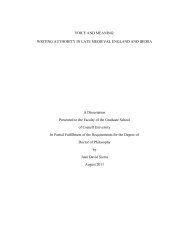Briana Anderson - Cornell University
Briana Anderson - Cornell University
Briana Anderson - Cornell University
You also want an ePaper? Increase the reach of your titles
YUMPU automatically turns print PDFs into web optimized ePapers that Google loves.
CHAPTER TWO<br />
BACKGROUND & PURPOSE OF STUDY<br />
Credibility<br />
Current literature on public relations indicates that the communication between<br />
an organization and its publics ought to be conceptualized as a relationship. This<br />
conceptualization uses aspects from interpersonal relationship research and applies<br />
them to the relationship an organization has with its stakeholders (Ledingham &<br />
Brunig, 2000). One such aspect of relationships is the concept of credibility, defined in<br />
Merriam-Webster dictionary as ‘the quality or power of inspiring belief’ (http://www.m-<br />
w.com/cgi-bin/dictionary). Credibility is essential if an organization seeks to build a strong<br />
relationship with its stakeholders (e.g. targeted consumers, shareholders, and<br />
employees), with the end result of increased market share, higher stock prices, or<br />
attracting quality employees. Moreover, a credible source can influence beliefs,<br />
opinions, attitudes based on a process termed internalization (Kelman, 1961), which<br />
states that a person accepts a source influence in terms of their personal attitude and<br />
value structure.<br />
Research on source credibility has produced different definitions and<br />
conceptions, but this study defines credibility in terms of the amount of perceived<br />
expertise and trustworthiness (Hovland & Weiss, 1951; Dholakia and Sternthal, 1977)<br />
of the source. Expertise is defined as the extent to which a source is perceived to<br />
make valid claims, whereas trustworthiness is defined as the degree of perceived<br />
honesty, integrity, and believability of a source (Erdogan, 1999). Advertising, public<br />
relations, and marketing researchers have used this conception of source credibility in<br />
studies related to both endorser credibility (Ohanian, 1990; Ohanian, 1991), and<br />
organizational credibility (Goldsmith et al., 2000).<br />
3

















